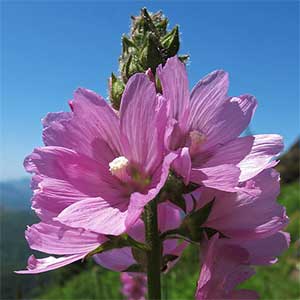Sidalcea hirtipes
Sidalcea diploscypha
bluff mallow, bristly-stem checker-mallow, bristly-stem checkerbloom, hairy-stem checkermallow
fringe checker mallow, fringe checkerbloom
several, scattered, erect, arising from rhizome apices, usually slightly hollow, densely, harshly bristly-hirsute, hairs stiff, pustular, simple, forked, or stellate, often 2–2.5 mm.
single, erect, usually branched distally, solid, both short-stellate-puberulent and long soft bristly-hairy, hairs erect.
basal and cauline;
stipules linear-subulate, 6–8 × 1–1.5 mm;
petioles of proximal leaves 20–30 cm, 3 times as long as blades, reduced distally to 1/2 times as long as blades;
blades: basal and proximalmost orbiculate to reniform, shallowly 5–9-lobed, 10–15 × 10–15 cm, thick, base narrowly cordate, lobe margins coarsely crenate-dentate, apex rounded, surfaces coarsely hirsute, hairs stiff;
distal orbiculate, deeply palmately 5–7-lobed, incised ± to base, lobes sometimes lobed again, base cuneate, apex acute, deeply 2–3-toothed, surfaces long-hirsute or with 2–4-rayed, stellate hairs abaxially.
basal, early-deciduous, and cauline;
mid to distal stem stipules divided into 2–5 filiform or linear segments, involucrelike, 10+ × 1 mm;
petiole (4–)6–20(–50) cm, usually 1/2 times to as long as blade;
basal leaf blades orbiculate, unlobed, 1–2.5 × 1–2.5 cm, base cordate, margins crenate, apex rounded;
cauline leaf blades orbiculate, palmately 5–7-lobed, (1–)2–6 × (1–)2–6 cm, lobes linear distally, sometimes 3-toothed or -lobed, then midtooth or lobe much longer than laterals, margins entire, surfaces bristly-puberulent.
erect, spiciform to subcapitate, dense, calyces usually conspicuously overlapping in flower and sometimes in fruit, proximals usually long-pedunculate, unbranched or branched, 20+-flowered, 10+ flowers usually open on spike at same time, not interrupted, not 1-sided, usually to 8 cm, usually not elongate but sometimes slightly elongated in some populations and to 20 cm in fruit;
bracts paired or single, linear, distal undivided, proximal distinct to base, 6 mm, mostly slightly longer than pedicels.
erect, dense, calyces overlapping, occasionally short-branched, clusters to 10-flowered, subumbellate to elongate in age, not 1-sided;
bracts linear or filiform, palmately 2–7-lobed, 8–12 mm, lobes linear, usually becoming involucrelike, 1–2.5 cm, subequal to or longer than calyx.
1–3(–5) mm;
involucellar bractlets absent.
1–3 mm, (short branches may easily be mistaken for pedicels);
involucellar bractlets absent.
bisexual or unisexual and pistillate, plants gynodioecious;
calyx often purple tinted, 9–11 mm, to 11–16 mm in fruit, margins ciliate, hairs 1–2 mm, surfaces finely stellate-hairy at base and with coarser, longer, simple and stellate hairs apically;
petals usually pale pink to rose-lavender, rarely white, slightly or not pale-veined, (9–)10–21 mm, pistillate often 9–14 mm;
staminal column 5–7(–10) mm, hairy;
anthers white;
stigmas 5–10.
bisexual;
calyx 8–12 mm, not much accrescent, lobes often with narrow purple line or spot at lobe base inside, outer surface bristly-hairy and stellate-puberulent, seldom densely glandular, multicellular hairs usually few or absent;
petals dark pink to deep purple, veins often paler, darker patch sometimes at base, 20–35 mm;
staminal column 4–6 mm, hairy;
anthers sessile on rim, white;
stigmas 5 or 6.
2.5–3.5 mm.
2 mm.
7–8 mm diam.;
mericarps 5–10, 3.5–4 mm, glabrous or sparsely stellate-puberulent, roughened, prominently reticulate-veined, sides rugose and pitted, back less so, mucro 0.6–0.8 mm.
6–7 mm diam.;
mericarps 5 or 6, sometimes pinkish when fresh, 2.5 mm, glabrous, back minutely hairy, back and sides reticulate-veined, back with prominent midvein, not pitted, mucro absent.
= 60.
= 20.
Sidalcea hirtipes
Sidalcea diploscypha
Of conservation concern.
Sidalcea hirtipes is uncommon and known from Clatsop, Lincoln, and Tillamook counties in Oregon and Clark, Lewis, and Wahkiakum counties in Washington. Its elevation and habitat vary, and it seems as much at home on steep coastal cliffs as in more inland, historic prairies and mountain meadows. Populations can appear to be large because of the long-rhizomatous and clonal nature of the plants; they are few and local. It is threatened by grazing, loss of habitat, fire suppression, road construction and maintenance, and changes in hydrology. It is a candidate for listing in Oregon and has been listed as endangered in Washington. Sidalcea hirtipes is characterized by its coarse indument of bristle hairs, its generally compact spikelike inflorescences, its relatively few, large, erect, hirsute leaves, and, especially, its extensive, coarse rhizomes. The inflorescences in some populations are elongated in fruit; its range, hirsute indument, and thick leaves along with coarse rhizomes help to distinguish it from other species. Stem internode length varies depending on habitat, as in many other Sidalcea. Molecular data suggest a relationship among S. hirtipes and S. asprella, S. celata, and S. gigantea (K. Andreasen and B. G. Baldwin 2003).
(Discussion copyrighted by Flora of North America; reprinted with permission.)
Sidalcea diploscypha is widespread in central and northern California and occurs also in Douglas County, Oregon, where it is apparently introduced. Young plants, even in flower, may resemble S. keckii, and transitional plants are known; S. diploscypha generally differs from S. keckii by its longer divided bracts, usually entire lobes on its distal stem leaves, simple bristles on the calyx, bristles absent at the standard mucro position on the mericarp, relatively few glandular and multicellular hairs, and generally clustered flowers and fruits. Plants in Colusa, Napa, Solano, and Yolo counties, California, are sometimes hard to distinguish from S. keckii, and vice versa. Some plants in Butte and Lake counties, California, also show some transitional features; none have yet been assigned to S. keckii.
(Discussion copyrighted by Flora of North America; reprinted with permission.)


